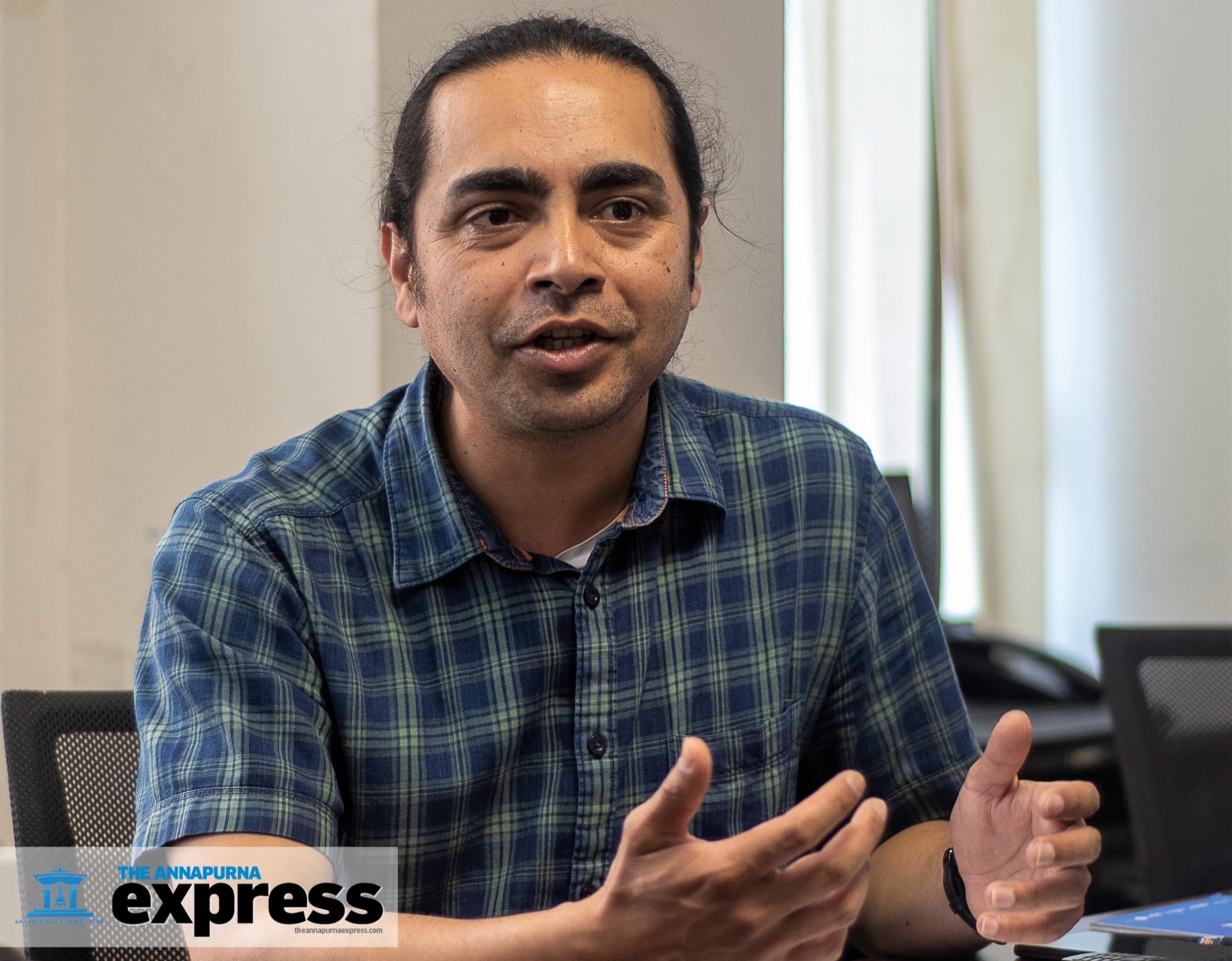Khilendra Paudel: Government role key to boosting remittance
Nepal’s economy heavily relies on remittances for foreign currencies, which is equivalent to more than 20 percent of its GDP. However, the remittance inflow decreased by nearly six percent in the first six months of the fiscal year 2021/22, according to a recent Nepal Rastra Bank report. This remittance contraction was observed despite an increase in the number of people going abroad for jobs following an improvement in the Covid-19 situation. Priyanjali Karn of ApEx talked to Khilendra Paudel, the CEO of IME, Nepal’s first remittance company, to know about the current remittance situation.
What role does remittance play in the economic wellbeing of Nepal?
The signing of the Treaty of Sugauli in 1816 ignited the trend of Nepali people migrating to foreign countries for employment, and this continues still. At present, approximately 3.5m Nepalis are working abroad, which accounts for almost 14 percent of the total Nepali population. The hard-earned money that migrant population sends back to their families is a major contributor to Nepal’s foreign currency earnings. The country receives about Rs 900bn in remittances through formal channels. This is about 25 percent of our gross domestic product (GDP). So remittance is one of the major factors that helps maintain the macroeconomic stability and the overall well-being of the country.
How do you think we can promote formal channels of remittance?
There is an undeniable need to formalize the channels through which remittances enter the country. For this, the role of government is pivotal. Policies in relation to economic growth, interest rate, and exchange rate policies are crucial determinants of remittance inflows. To encourage the inflow of remittances through formal channels, introduction of special incentive packages for the migrant population can serve as a mode of encouragement. This method is currently being practiced by some of the SAARC countries like Sri Lanka, Bangladesh, and Pakistan, whose economies, like Nepal’s, heavily depend on remittances.
Despite their contribution to the country’s economy, many workers are still being swindled and exploited. What do you think should be done to guarantee the safety of migrant workers?
Ensuring the safety and security of Nepali people migrating abroad for employment has to be the highly prioritized by the concerned government bodies. Entering into a bilateral labor agreement with the countries of destination indeed plays an important role in assuring the wellbeing and security of workers. Nepal has labor pacts with just nine of the 109 major destination countries, namely the State of Qatar, the United Arab Emirates, the Republic of Korea, the Kingdom of Bahrain, Japan, the Hashemite Kingdom of Jordan, Malaysia and Mauritius. Thus, entering into labor agreements with other major destination countries can be the first step toward safe migration.
How has IME been responsible and accountable to the workers and contributed to the incoming remittances?
For the past 20 years, IME Limited has been serving the migrant workers involved in foreign employment by facilitating them to send back their hard-earned money to their families in the safest, credible, and secure way. No matter the hardship of the situation, IME has always made an effort to make remittance services affordable and accessible. Where IME stands today is solely because of the reliable service we have been offering to the Nepali migrant workers. As a pioneer in formalizing the remittance channel, today, IME takes pride in bringing in remittance money from more than 100 countries.
IME is not just a remittance company but also a conglomerate of businesses. One key area where the group works is capital market. Why do you think Nepal should focus on connecting remittances to the capital market?
We are well aware of public enthusiasm for the IPO (initial public offering) and share market. This can be one of the best opportunities for Nepal to leverage the interest of the public by connecting remittances to the capital market. Allocating a quota for the migrant population can promote formal channels as well as encourage investment in productive sectors.
ApEx Roundtable: Talking mental health on election eve
As a part of our campaign to bring mental health awareness and help improve the country’s mental health institutional setup, ApEx on May 8 organized a roundtable of mental health professionals. Held on the eve of the May 13 local elections, this time, we wanted to understand the kind of steps that are necessary at the policy-making level in order to boost the mental wellbeing of Nepal’s nearly 30 million citizens—especially its youth population in the 16-40 age bracket.
Local governments poorly informed on mental health
Dr Basu Dev Karki
Lead Consultant Psychiatrist, Patan Mental Hospital

The big problem now is that people are still unaware of their needs and basic rights when it comes to accessing mental health services. Local governments are supposed to provide mental health services to their citizens, but they themselves are poorly informed.
At the policy-making level, mental health is still not our priority. We as a country are yet to accept that mental health is directly connected to our quality of life.
The Sustainable Development Goals, which also includes mental health, have been stuck in the ‘implementation phase’ for the past seven years. In the meantime, our suicide rate is increasing.
If mental health is not a priority at the policy level, how can we expect the general people to prioritize it? In business, whoever brands themselves the best wins in the market. But unlike the case with physical health, we have been unable to brand mental health awareness.
There are mental health-related policies in place, so much so that municipalities are provided with the necessary budget, human resources, and training for mental health awareness and services. These municipalities also have the responsibility of training health workers and program managers on mental health. Yet they still don’t realize that this is an important and urgent issue. There is also no mechanism to monitor their work in this area.
Awareness should not be an event, it should rather be a movement.
Most mental health professionals don’t have adequate training
Kapil Sharma
Counseling Psychologist and Psycho-social Counselor at HUDEC Nepal

We need to look at mental health through the psychosocial lens as well. No doubt, sensitization and awareness on this topic is growing among the youths. But we still don’t talk about mental health in general.
In the majority of the cases, individuals, even if they realize that they are in need of first-hand mental health support, don’t know where to go, and they can’t even talk about it with their families. How can we expect the topic of mental wellbeing to be normalized when there is no social support for it?
From the perspective of service providers, there are many training programs. But as these mental health trainings are not as prioritized as physical health training, our mental health service providers aren’t equipped to tackle the scale of the current mental health crisis.
One needs social motivation to seek support, which is lacking at the community level. It's a two-way challenge: Are service providers competent enough to provide the needed services? And are the service seekers aware enough of the services they should seek?
Today’s youths live online. While there is an overload of information they can simply google, there is no way to guide them to understand their own mental issues or that of others. I’ve had clients who google their symptoms and self-diagnose—rather than look for one-to-one support before jumping to conclusions.
There are many aspects to mental health awareness, and we need to look into all of them to better understand our own mental health.
About time the country implemented a referral system
Shreeya Giri
Mental Health Advocate, Founder of Happy Minds

As an online mental health service provider, our operation exists on a digital platform. That is, we are cent percent dependent on gadgets, electricity, Wi-Fi, and mobile data to ensure that the needed support is being given to those who can’t access in-person services.
Yet there is no guarantee of when the power will be cut and when the network will be interrupted. These faults in the infrastructure make such mental health services hard to access. If there are no digital infrastructures in certain parts of Nepal, people cannot access our services at all. So how do we help people in those areas who are in dire need of support?
Unawareness and unavailability of these services lead to one common issue: we normalize mental health problems. Psychological abuse at the workplace and in the household is considered normal. Many people who are being emotionally abused don’t come forward and don’t get the right guidance. Even if people are aware that they need help, they don’t recognize what exactly it is that they need or that they can find the right person to talk to.
To spread mental health awareness, Nepal needs a referral structure. How long will we keep saying that people don’t seek mental health support because they don’t feel the need? Every day in hospitals people are going through traumatic experiences. If the doctors can refer them to a counselor or a psychologist, they will get the necessary support to overcome their mental trauma. This can prevent future mental illnesses.
In 2021, the government had set aside a budget of 1 percent for mental health services. But even this amount hasn't been properly utilized. The Health Ministry hasn't been able to mobilize experts to make the most out of it.
We need to better utilize existing platforms
Dr Rishav Koirala
Psychiatrist, Grande Hospital and Executive Director at Brain and Neuroscience Center, Nepal

The most important part of awareness is amplifying conversations on the promotion of positive mental health and prevention of possible mental illnesses. Normally, we have a habit of seeking help at the last moment. If we can take action now instead of tomorrow, the situation of mental health in Nepal will significantly improve.
Youths are the most aware of mental health, yet they can’t separate between right and wrong emotions, normal and abnormal suffering.
Moreover, the large population of working-class people in our country is aware of the support infrastructure as well as support via digital platforms. What they lack is the knowledge of where these infrastructures are and how they can be accessed.
We need to find better ways to utilize these existing platforms and create awareness in such a way that every individual is aware of where they can find these spaces, how they can communicate, and what signs and symptoms they should be aware of to seek professional help.
We can blame the stigma on mental illness for the current crisis. But it is also important to analyze how this stigma came to be and how we can eliminate it. Seventy years ago, there wasn’t a well-equipped mental health service-provider in Nepal. People weren’t aware of mental illnesses. Only when a person had reached a terminal stage, at the peak of their illness, were they considered mentally ill. Psychosis is a terminal mental illness, and this was what people labeled a mental health problem, and so the stigma of mental health began.
Times are changing, and Nepal has come a long way in terms of awareness and mental health services. Yet many people still believe in that stigma and the thought of mental illness scares them. It all comes down to awareness and changing the perspective on mental health.
Sumina Shrestha: The skin is her canvas
As a kid, every evening Sumina Shrestha would run to her artist neighbor to watch him draw.
She was intrigued at how portrays and landscapes would come to life on drawing papers, and desired to do so herself.
Inspired by her neighbor, Shrestha, now 27, says she started sketching and doodling from a young age.
She grew up in the Dillibazar area of Kathmandu, and at school, she got excited whenever classwork required drawing diagrams.
Drawing meant everything to her, a pursuit that she was involved in most of the time. As she got better at it, she began drawing more intricate details. Her sketchbook became her constant companion.
“People around me would tell me that my work was really good, and that motivated me to keep drawing,” she says.
The young Shrestha knew she would become an artist, but didn’t know what kind of artist.
After finishing her school in 2012, she enrolled into Srijana College of Fine Arts to follow her dream. She graduated in 2015, and that was when a devastating earthquake struck Nepal. It was the deadliest natural disaster the country had ever seen. Thousands of people were killed and properties worth billions of rupees were reduced to rubble. The incident had a profound impact on Shrestha, she says.
“I realized how unpredictable life can be, that anything could happen anytime,” she says, “I was filled with the urgency to do something I loved, which was becoming an artist.”
Shrestha dabbled in thanka painting and drawing cartoons for a while, but they never gave her much joy. She then tried her hands at tattoo-making—and instantly fell in love with the craft.
Although she had always been interested in tattoo-design, becoming a tattoo artist was not something they ever thought about.
“Tattoos for me were just an interest. I never planned on learning the art form or becoming a tattoo artist for that matter,” Shrestha says. “I found tattoos cool and that was about it.”
She bought a tattoo machine with the money she had saved from making some commissioned artworks and started practicing on a rubber skin.
The feel of the vibrating tattoo machine in her hand and the humming noise it made gave her great joy. Throughout 2015, Shrestha says, she spent hour after hour making tattoos on a rubber skin.
She also joined an organization of artists called ‘Get Well Soon’, which was created after the earthquake, and met other emerging and established artists from different fields of arts. The organization already had a smattering of tattoo artists and Shrestha felt right at home.
There weren’t many female tattoo artists in Nepal when Shrestha was starting. Tattoo artists were mostly men, and it was considered a men's job.
Shrestha feels fortunate that her family supported her when she expressed her desire to be a tattoo artist.
“This is not a conventional career, particularly for Nepali women. When I got started, tattoo culture in our country was still in its early days. So getting the support of my parents was really important,” she says.
She adds that the paucity of female artists in Nepal was also a strong motivator.
“Entering a male-dominated field was both challenging and motivating. I knew many clients would rebuff a female tattoo artist, but I never let that affect me,” she says. “I wanted to prove myself with my work.”
Shrestha started her career as a tattoo artist at Tattoo Pasal, a studio run by her friend at Jhochhen of Basantapur.
She worked there for two years and the first tattoo she ever made was on her sister.
In 2017, she got an offer from a Nepali-run tattoo studio in India, where she worked for little over a month before deciding to return home. Soon after, Shrestha landed another job as an artist and tattoo parlor operator at Thamel.
“This studio was located inside the premises of Wanderthirst Hostel at Thamel. There I was allowed to work on my own terms,” she says.
This opportunity helped Shrestha realize that she could open her own tattoo studio. While still working at the studio, she set up her shop, Suminu Tattoo, inside the hostel. She ran both the studios for three years before finally deciding to focus on her own business. She rented a space at Thamel and moved her studio there.
For Shrestha, making tattoos is a way of connecting with people, and learning their life stories and experiences.
“With every client, it is a new canvas, a different skin color, a different story and experience,” she says. “I get to interact with many interesting people as a tattoo artist, which is my favorite thing about this job.”
Chaitanya Subba obituary: A scholar of indigenous communities
Chaitanya Subba, a scholar of Limbu culture, indigenous rights activist, and development planner, died on May 3. He was 75.
Born in 1946 in Thechambu, Taplejung, Subba devoted most of his adult life to academics and research.
His father Jagatman Menyangbo Subba was a schoolteacher, and encouraged Subba to read and write from his childhood. He studied at Bhanu Secondary School, which was established by his father, until his early teens, and got his school leaving certificate (SLC) from Dharan in 1963.
After completing his schooling, Subba enrolled at Inam Campus in his home district of Taplejung for Intermediate of Arts (IA). At the same time, he started teaching at Bhanu Secondary School and later went on to become its headmaster.
As a young and educated man in his district, Subba was made a Panchayat member of Taplejung in 1967. Subba then went on to get a Master’s degree in Political Science from the Tribhuvan University in 1976.
His academic bent of mind always drove him to scholarly pursuits. Politics was important to him but not as much as academia.
“He thirsted for knowledge all his life. That was his lifelong passion,” says his wife Sandhya.
No wonder then that Subba gained prominence more as a scholar than a politician—even though he was a founding member of the then Social Democratic Party.
Subba, who also served as a member of the National Planning Commission, is mostly known as an expert in Nepal’s indigenous communities.
He founded the Adivasi Janajati Development Committee in Nepal. As the committee’s chairperson, he played a significant role in the formation of the National Foundation For Development of Indigenous Nationalities (Adivasi Janajati Utthan Rashtriya Pratisthan).
Subba also published several research papers and books on Nepal’s indigenous communities. He was considered an authority in Limbu culture and religion owing to his vast knowledge in Mundhum (ancient Limbu religious scripture and folklore). In 1991, he published the book ‘Culture and Religion of Limbus’.
Subba played a pivotal role in inserting a clause on the promotion of the rights of indigenous communities in the 10th plan (2002 to 2007) of the National Planning Commission. Besides his contribution to the indigenous communities, Subba was also a scholar in drug abuse and rehabilitation.
He operated many drug rehabilitation centers and published several research papers on drug abuse and rehabilitation. In the 1980s, he even worked as the executive director of Drug Abuse Prevention Association of Nepal (DAPAN). In his later years he served as an executive member of the International Organization of Good Templars South and Southeast Asia Regional Council and a UNDP project consultant.
Subba’s daughter Srijana remembers her father as a profoundly learned man, who spent a lot of time in his study even after his retirement.
Talking about his other attributes, she speaks of her father’s health consciousness. “He never missed his morning walks, even when it was raining. Also, he was always immaculately dressed,” she says.
Phoolman Chaudhary, the Asia representative in the United Nations Permanent Forum on Indigenous Issues, describes Subba as “an eminent academic, leader, and guide who dedicated his life to the development of the indigenous peoples of Nepal”.
Subba had for long been suffering from diabetes and hypertension. He passed away due to complications from a heart surgery. He is survived by his wife, a daughter, and two sons.
Born: 14 September 1946, Taplejung
Death: 3 May 2022, Kathmandu
Happy Minds: Promoting mental health across Nepal
In the past two years, suicide rate in Nepal has increased by 25 percent, according to a Nepal Police data. In an average, 19 people commit suicide every day. Mental health experts say there has been a sharp decline in mental wellbeing due to the Covid-19 pandemic. Cases of stress, anxiety and depression went up during months-long lockdowns. And so did cases of suicide.
Shreeya Giri, founder of Happy Minds and a mental health advocate, found herself struggling with her mental health during the pandemic.
She was studying in London when covid started. The pandemic and lockdown took a severe mental toll on her.
“I was clinically depressed,” she says. “I found myself constantly checking the news that gave me anxiety and sleep issues.”
Giri finally decided to seek professional help and tried to reach out to mental health service providers in Nepal offering online counseling. But, to her dismay, got no reply from them.
She returned to Nepal in December of 2020, and soon realized that there weren’t many easily available mental health services for people who need it like she did.
“It takes a lot to realize that you need help with your mental health, and to look around and find no one who can help you is a terrible feeling,” she says. “I wanted to do something to bridge that gap.”

In April 2021, Giri founded Happy Minds, an online mental health and wellbeing platform that provides digital mental health literacy and mental health counseling services. The company raises awareness on mental health and psychology and offers people easy-to-access platform through which they can connect to mental health professionals both online and in-person.
“From the very first day we started, we were already juggling between eight to 15 clients,” Giri says, “It just goes to show the state of people’s mental wellbeing.”
With growing number of people in need of help, Happy Minds added more therapists who were passionate and willing to give any hour of their day to counsel a person in need of mental and emotional support.
More than 2,500 people have already availed services provided by the mental health and well-being platform and the number is growing.
Happy Minds caters to the general public from all over Nepal. The platform only offered online counseling for the first six months before starting in-person sessions. It currently has a team of more than 20 mental health professionals specializing in different aspects of mental health to help the clients based on their specific needs.
Happy Minds is also the first company in Nepal to introduce Employ Assistance Program (EAP), an initiative sponsored by companies to give free mental health services to their employees. Companies applying for this program get a 24/7 accessible toll free hotline service that their employees can reach.

The company had been running for barely three months when it was nominated for the Global Startup Awards SAARC, an award that is given to startups that are positively disrupting the market and making a big impact in the society. Out of 2,500 nominees, Happy Minds was recently named one of the two finalists in the best newcomer category representing Nepal.
Buoyed by the praise and success of the company, Happy Minds now wants to expand its services centers across the country. It aims to have at least one easily accessible mental health aid in every village, where people can reach out to for support, any time of the day.
It is also planning to bring out more learning and training programs to spread the importance of mental health and wellbeing, teach people how they can be aware and empathetic to themselves and others, and promote a healthy and sound mental health. Happy Minds also want to extend its EAP services to more companies, schools, and corporate houses.
Giri says the state of mental health in Nepal is alarming and yet the government is doing very little to address it. Only one percent of the health budget was set aside for mental health in 2021.
“The government should realize the importance of mental health and do more to help its many distraught and desperate citizens,” she says.
Becoming one of the regional finalists in the Global Startup Awards from the SAARC region has offered some hope to Giri and her company.
If it wins, Happy Minds can access national and international donors, funds, resources and training programs. It can even draw attention to the current mental health status and how it can be improved.
Ganesh Dhakal: Giving the dead a final farewell
At Pashupati Aryaghat, the mood is always somber. People come here to cremate their loved ones at one of the many ghats by the banks of the sacred Bagmati river.
On this particular afternoon, a body is burning on a pyre and the deceased’s friends and family members are there to say their last goodbyes. As the lapping flames consume the dead, the mourning family sits there still, watching the fire intently—as though seeking some sort of catharsis, a closure. Friends and neighbors approach them to offer condolence. These exchanges are brief and in hushed tones.
While all this is happening, the cremator Ganesh Dhakal sits alone on one of the metal benches, separated from the rest. His gaze is fixed on the burning pyre. Every now and then, he gets up, moves towards the blazing heap with a bamboo pole on his hands, and prods the red-hot logs. He is making sure the body is burning properly.
Clad in a smoke-stained white dhoti, he returns to his seat and once again proceeds to look at the pyre. It’s hard to discern his emotion at this moment. He seems steely, mirthless.
I am wrong. Dhakal is very much a family man with a wife and nine children. For him burning the dead is just a job, even if an unusual one.
“I’ve been here for 40 years,” the 57-year-old says. “I came to Kathmandu to find a proper job but fate had other plans.”
Born to a poor family in Nagarkot of Bhaktapur district, Dhakal came to Kathmandu in 1982 with a dream of working for a big company. He was just 16 then.
One of the first things he did after arriving in Kathmandu was visit the Pashupatinath temple. For a young boy, looking for a job, Dhakal says, it was fortuitous that he came across the Aryaghat cremators who tasked him with carrying logs to burn bodies.
“I was desperate to make a living in the city, so I happily took the offer,” Dhakal says.
He brought logs for the cremators and watched them at their job. But being a cremator was not something he aspired to be. He still dreamt of a normal job.
But as the years went on, Dhakal says, he realized his prospect of getting other jobs was limited. To survive in the city, he still needed to earn more than what he was earning at the time.
“Becoming a cremator was my only option,” he says. “I didn’t have time or choice.”
Having burned hundreds of bodies over the decades, Dhakal says he has learned to separate his personal and professional lives. Whatever he does for a job, he leaves it at Aryaghat. At home, he takes on his family role—as a husband, a father, and the family’s breadwinner.
Dhakal lives in Chabahil with his wife, who suffers from a medical condition where she can’t walk, and their six daughters and three sons. He burns the dead so that his family can survive in Kathmandu.
When Dhakal was just starting off as a cremator, he tells me, he used to get emotional.
“I used to get carried away by the sadness of the lost lives and their grieving families that came here every day. I have learned to cope with my emotions over the years,” he says, “to see it as just something I do.”
Between our conversation, Dhakal has been approaching the pyre to give a few nudges to the burning logs with his bamboo pole. By now, my impression of him has already changed. He is very much capable of human emotions. The only thing that separates him from most others is that he can compartmentalize his emotions—hence his nonchalance to burning bodies.
“People keep asking me why I chose to be a cremator when I had a choice to get other jobs. But the truth is that any other choice wouldn’t have helped me get out of poverty,” Dhakal says. “When I decided to become a cremator, I was already sinking in poverty. This was the only skill I could easily learn and I was already working at Aryaghat.”
He earns Rs 1,500 for cremating a body, which he does once every four to five days.
Dhakal says he has long forgotten his boyhood dream of joining a big company and accepted his current situation.
“Once I got used to this work, I never thought of quitting and looking for other jobs. After all, this job helped me raise my family,” he says.
He plans on continuing so long as his health and strength permit him to do so.
The burning pyre has now crumbled into a heap of smoldering ashes. Dhakal gets up to help the priest to collect asthu (cremated remains) to hand them over to the family members.
The funeral attendees begin filing away, saying their condolences to bereaved family members. Soon, the funeral ceremony is completed, and the family members of the deceased also leave Aryaghat.
Dhakal splashes water over the cremation platform, washing away the remaining coals and ashes into the Bagmati river. Another body will soon be cremated at this spot, and Dhakal will be there for the job.
“Again, it’s just a job,” he tells me calmly, “and someone has to do it.”
Bishnu Raj Acharya obituary: Congress stalwart from Kapilvastu
Bishnu Raj Acharya, former member of parliament and Nepali Congress (NC) leader, passed away on April 23. He was 74.
Acharya, born and raised in Bharatpur of Kaski district, went to Varanasi, India to pursue his higher studies. His political rite of passage happened during his college years in India after he met Congress leaders BP Koirala, Ganesh Man Singh and Krishna Prasad Bhattarai, among others.
He started building an interest in political discourse and began participating in party meetings and his involvement in politics only increased after returning to Nepal. Acharya’s political career as a Congress cadre started from Kapilvastu district from where he played an active role in the 1990 democratic movement.
His contribution to the movement didn’t go unnoticed, and the party gave him a ticket to contest the 1991 general elections.
Acharya won and became a member of the parliament from Kapilvastu Constituency No. 3. He was re-elected in the 1994 elections.
Although he had made Buddhabhumi of Kapilvastu his home, he later moved to Kathmandu with his family. But Acharya was always connected to Kapilvastu; it was the place where he had come of age politically.
When he was just starting out in politics, Kapilvastu, and particularly his village of Buddhabhumi, was poor and underdeveloped. The party-less Panchayat government of the time had not paid much attention to the plights of its residents. It was Acharya who brought various infrastructure projects and development programs to the district. As a parliamentarian, he helped build health posts, school buildings, roads, bridges and water supply facilities in various parts of Kapilvastu.
In 1996, Acharya worked closely with late Girija Prasad Koirala, the then Congress president and parliamentary party leader. He was among Koirala's most trusted, says Surendra Raj Acharya, another NC leader and lawmaker.
Surendra Raj says Acharya was a respected figure both in and outside the party.
“He was loyal to his constituents and always worked to improve their living conditions,” Surendra Raj tells ApEx, remembering Acharya. “He didn't have one bad habit.”
Other NC leaders remember Acharya as a veteran leader who helped build the party organization in Kapilvastu.
NC President and Prime Minister Sher Bahadur Deuba described Acharya’s passing as an irreparable loss to the party.
“Late Acharya’s contribution to the party and Nepal's democratic movements will always be remembered,” Deuba said in his condolence message.
Acharya had long suffered from diabetes. His condition had deteriorated after a surgery of his leg. He died at his residence in Budhanilkantha, Kathmandu. He is survived by his wife and their three daughters.
Birth: 1948, Kaski
Death: 23 April 2022, Kathmandu
Tazung: Breathing new life into a nearly forgotten brand
Tazung Hang Rai’s family launched ‘Tazung’, as an online clothing store, in 2019. In the initial days, the store mainly sold lifestyle and winter wear. But the sales figures were not encouraging. In fact, the business struggled to attract customers.
In its first year of operation, Tazung products didn’t find much success. The brand essentially failed to make its mark. The family had to decide the future of the business. They had to either reinvent Tazung or fold the operation. Enter 19-year-old Tazung Hang Rai, the brand’s namesake, and his friend 17-year-old Shrayaskar Jung Bahadur Singh.
The two friends took over the business in 2020 and ran with it. The duo immediately figured out what was keeping the customers from buying Tazung products: the clothes were too common and uninspiring.
The young and fashion-forward boys turned the failing business over its head and brought the brand to prominence. Today, Tazung caters to young urban customers with its range of quality and trendy street- and sports-wear. “Tazung sells one-of-a-kind street and sports apparels. Comfort, quality, and style are our brand’s main focus,” says Rai.
“While building a platform for modern fashion, we also want to create a community that promotes the growing street culture.” Tazung’s products are cool, ultra-casual, and decidedly modern.
Singh had an experience in the clothing business where they customized jeans jackets by hand painting them with his brothers. He had a vision for what Tazung’s products were going to be like.
“If you look at the young urban Nepali crowd, everybody wants to be trendy. We simply wanted to be the brand that understood that trend and provided the products,” he says.
Rai takes inspiration from his fashion designer mother. During the Covid-19 lockdown in 2020, he even enrolled himself in a fashion-designing course to “get a better idea of designing and marketing”.
The two young business partners researched what the modern Nepali youths were wearing, and the kind of culture they were into in order to design Tazung products. “We incorporate ideas from rap videos while producing videos for our brand, solely focused on the street- fashion,” says Singh.
Both Singh and Rai understand the power of digital marketing. They are not to vaunt their products on social media platforms. They seem to know how a brand is built, and they are determined to create one.
From putting down the ideas for their latest product design to fabric selection, sampling and model fitting to production, the two partners are involved in every aspect of the enterprise. They experiment with different designs and fabrics to keep the youth spirit alive.
For product marketing, they rely on unique and creative photo and video shoots, and upload them on their website and social media. “We want to add more value to our products by giving the customers something that would be trendy for a long time. At the same time, we also keep an eye on the trends and adapt accordingly,” says Rai.
The brand that was once unable to find its customer base has had a rebirth. Until the present, Tazung has made about 100,000 sales. It releases a new collection every season, and they bring out the products within the collection every two weeks.
The brand is currently only available in Kathmandu, but Rai and Singh say they are aiming to take their products to other cities like Pokhara and Chitwan. They also plan to expand their production targeting the Nepalis living abroad.
Tazung is also in the process of opening its first store in Maharajgunj, Kathmandu. “We want to promote Nepali street culture, arts, and fashion,” says Rai. “For that, we are planning to collaborate with young Nepali artists.”
















